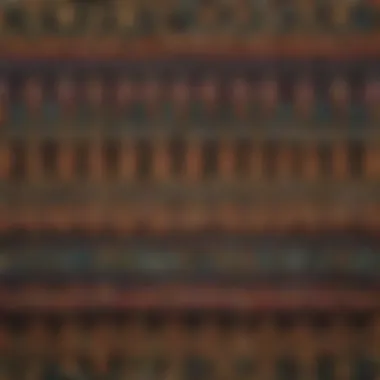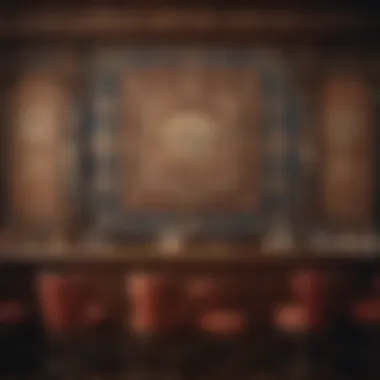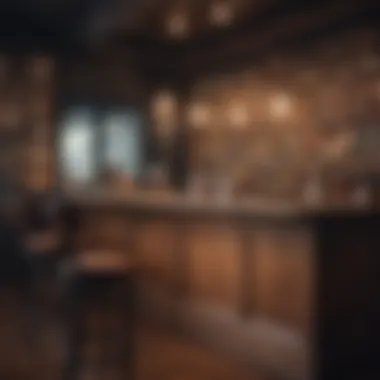Exploring the Intricacies of Bar Tapestry Art


Intro
The world of bar tapestry is an intricate web of history, artistry, and culture. This textile form weaves together stories from different epochs and styles, transcending mere decoration to encompass a rich tapestry of meaning and emotional depth. From its historic origins to its modern applications in chic decor, bar tapestry represents more than just a visually appealing fabric; it encapsulates unspoken narratives of communities and traditions.
As we delve into this fascinating realm, we'll uncover the techniques that distinguish bar tapestry from other textile arts. Integral to this exploration is a look into the construction methods, artistic motifs, and the cultural significance that these works hold today. No less important is the emergence of contemporary interpretations that breathe new life into this age-old craft.
Within the landscape of interior design and fashion, bar tapestry has carved out its niche, making it a relevant subject for designers, retailers, stylists, and even students and influencers alike. The synthesis of sustainability with traditional craftsmanship adds more layers to this conversation, making it not just a study of art but also a critical reflection on today's values in fashion and decor.
As we navigate through the insights and trends surrounding this textile tradition, we invite you to appreciate its multifaceted beauty and significance in modern contexts.
Preamble to Bar Tapestry
Bar tapestry is not just a craft; it’s a unique storytelling medium that has woven itself into the fabric of cultures across centuries. Understanding its distinct characteristics sets the stage for appreciating how this art form continues to evolve and make its mark on contemporary aesthetics.
Defining Bar Tapestry
Bar tapestry is essentially a specific form of weaving that employs distinct techniques and motifs to create decorative pieces. This style typically showcases intricate graphics and patterns, often drawing inspiration from folklore, nature, or abstract concepts. Unlike other tapestry forms, bar tapestry is recognized for its close attention to detail and the choice of material, which contributes greatly to the finished image.
When we talk about bar tapestry, we’re delving into a world where texture meets storytelling. It’s an art where the weaver’s personal touch shines through. Each piece offers a glimpse into the meaning behind the patterns and colors, serving as a canvas for cultural representation or emotional expression.
Historical Overview
The history of bar tapestry stretches back through the ages, each era marking its progression and adaptation. It began in ancient civilizations, where textiles were not only functional but were imbued with social and spiritual narratives. Some traces can be found as far back as the Byzantine Empire, where artisans mixed various materials to enhance durability and vibrancy.
The Renaissance brought renewed interest, where bar tapestry gained popularity as status symbols among the affluent. Wealthy patrons commissioned weavers to create detailed works that depicted grand stories, displaying them in their homes as a mark of prestige. This intertwining of wealth and artistry ensured that bar tapestries were both seen as decorative and revered for their craftsmanship.
While its significance waned during industrialization, a revival occurred in the latter half of the 20th century, as artists began exploring traditional techniques alongside modern materials and concepts. This fusion resulted in fresh interpretations, making the bar tapestry relevant for today’s designers and interior decorators.
The exploration of materials used in bar tapestry reveals how swapinmg threads can create depth and contrast. From using natural fibers to synthetic blends, each choice affects not just appearance, but also texture and durability.
The cultural significance of bar tapestry cannot be overstated. Pieces often carry symbols or motifs that reflect community values, beliefs, and stories passed through generations. Through this art, we can see a reflection of collective identities, with each tapestry being a narrative thread in the extensive quilt of human experience.
Artistic Elements of Bar Tapestry
Understanding the artistic elements of bar tapestry is fundamental for grasping its intricate beauty and rich history. It's where creativity meets meticulous craftsmanship. Each tapestry serves as a canvas, not only displaying the skills of the weaver but also telling stories, representing culture, and expressing emotions. The shared experience of artists and viewers alike is deeply rooted in these woven textiles, making it an essential topic for designers, retailers, and artists.
Material Selection
When we talk about material selection, we're looking at the backbone of any tapestry. Different fibers contribute distinctive qualities. For example, wool, often chosen for its durability, warmth, and natural sheen, provides a lush background. Cotton is another popular option. It allows for finer detail but lacks the softness of wool. Linen has a lovely texture and can really make colors pop, despite being less commonly used.
"The choice of material is like the stage for a performance; it sets the tone and influences the storytelling."
It's not just about the fibers, though. Think about the dye process. Traditionally, natural dyes from plants and minerals were used, giving a rich palette. Today, synthetic dyes make colors more vibrant and uniform but can lack the depth of their natural counterparts. The material choice ultimately influences the textile’s aesthetic and tactile quality.
Weaving Techniques
Moving on to weaving techniques, these define the structure and complexity of the design. In contrast to standard weaving, bar tapestry involves a unique method that showcases intricate patterns and imagery. Common techniques like hatching, twill, and plain weave each offer distinct visual effects and adaptation opportunities. The skilled hands of the weaver create textures through varied tension and stitch size, which play a big role in the final look of the piece.
For example, a skilled artisan might choose to blend techniques selectively, incorporating tufting to add dimensionality or using perlé thread for unique highlights, which creates a stunning finish that draws viewers in.
Additionally, innovations in loom technology have pushed the boundaries of what can be done, allowing for a new world of possibilities without ditching traditional craftsmanship. The balance of old and new enhances both skill and storytelling in bar tapestry.
Color Theory in Tapestry
Last but not least, let’s explore color theory in tapestry. Color isn't just decoration; it's emotion. Think about how reds can evoke warmth while blues induce calm. The artist’s color choices tell a story, directing the viewer’s emotional response. The blend of hues can transform a piece entirely; a subtle gradient or bold juxtaposition can set an entirely different mood.
When creating a tapestry, it’s common to consider not just individual colors but how they interact. Contrast or harmony can shift the element of surprise and balance within a tapestry. For instance, an orderly arrangement of complementary colors can provide a certain type of visual satisfaction, while a chaotic blend might evoke more playful or unexpected emotions.


Incorporating principles of color theory not only adds depth but also marries the aesthetic with the emotional, enhancing viewer engagement.
In summary, the artistic elements of bar tapestry—from the choice of materials and techniques to the application of color—form the heart of the tapestry’s narrative. Each decision made by the artist speaks volumes, connecting us with histories, cultures, and emotions, while also holding relevance in modern design contexts.
Cultural Significance of Bar Tapestry
Bar tapestry holds a cherished place in the broader spectrum of textile art, not only for its aesthetic appeal but also for its profound cultural ramifications. This medium serves as a narrative device, weaving stories of communities and epochs into the very fabric of its creation. With each thread interlaced in a meticulous fashion, bar tapestry embodies more than just artistry; it signifies communal identity and historical continuity. The rich tapestries created through this medium often reflect the values, beliefs, and traditions of distinct cultures, allowing viewers a glimpse into the ethos of the weavers' societies.
One cannot overlook how bar tapestries engage with contemporary societal dialogues. They serve as a form of expression, channeling both personal and collective experiences while addressing themes such as environmentalism, identity, and social justice. In this way, they resonate with modern audiences, eliciting a deeper consciousness around the techniques and narratives behind the craft. The cultural significance of bar tapestry is intricately tied to its ability to forge connections, bridging generational gaps while highlighting variations in technique, style, and symbolism across regions.
Regional Variations
The diverse nature of bar tapestry is captured beautifully through its regional variations, with each locale imbuing unique characteristics that resonate with its cultural identity. From the bold motifs characteristic of Scandinavian designs to the intricate patterns found in Middle Eastern tapestries, these creations serve as cultural mirrors reflecting the stories of their origins. For instance, in the Andean region, vibrant colors and geometric shapes tell tales of ancient civilizations, while Japanese bar tapestries often incorporate subdued hues, aligning with Zen philosophies and nature.
These regional styles not only showcase local craftsmanship, but also underscore the dynamic influences of historical events, trade routes, and cultural exchanges. As such, bar tapestry is not static, but rather an evolving art form that adapts to its social and environmental contexts, often in surprising ways. By studying these variations, designers and artists can draw inspiration, transforming traditional elements into contemporary applications.
Symbolism in Design
Delving into the symbolism embedded within bar tapestry reveals a rich tapestry (pun intended) of meaning and significance. Each design element serves a purpose, often rooted in cultural narratives that span generations. For example, motifs like the tree of life symbolize growth and interconnectedness, while animals may represent strength, guardianship, or community values. In many Indigenous cultures, symbols are employed not just for decoration; they narrate the stories of ancestors, spiritual beliefs, and natural elements.
Moreover, the interpretations of colors within bar tapestry are significant. Red may evoke passion, while blue could represent tranquility. Designers keen on integrating tapestry concepts into modern projects must engage with these layers of meaning to create works that resonate both visually and emotionally.
"Each knot and thread is a whisper of the past, speaking of heritage and identity."
Through understanding the symbolism in tapestry design, a contemporary artist can breathe new life into age-old techniques, marrying tradition with modernity. This fusion not only propels the relevance of bar tapestry into current fashion and decor but also emphasizes the importance of preserving cultural stories and practices for future generations.
Bar tapestry is more than a decorative art form; it is a thriving symbol of cultural richness, community continuity, and a potent means of storytelling through textile artistry.
Bar Tapestry in Fashion
Bar tapestry holds a unique role in the fashion world, acting as a bridge between traditional craftsmanship and contemporary design sensibilities. This intricate textile art form has not only been a canvas for creative expression but has also found its way into garments, accessories, and runway presentations, making it a key player in the appreciation of textiles within fashion.
The significance of bar tapestry in fashion chiefly lies in its textural richness and visual storytelling. Each piece crafted can narrate a story or evoke a specific mood, engaging the wearer and viewer alike. Designers have tapped into the vibrant colors, detailed motifs, and historical contexts of bar tapestries to juxtapose them against modern silhouettes, creating a dialogue between old and new. This ongoing conversation reaffirms the importance of heritage in contemporary fashion, making bar tapestry not just an aesthetic choice, but a statement about identity and cultural roots.
Spotlight on Designers
Several designers have made significant waves by integrating bar tapestry into their collections. A standout name is Marni, known for its bold prints and eclectic designs. They have played with the textures and motifs of bar tapestry, infusing their garments with a retro flair that resonates with their artistic vision. Another notable example is Etro, famous for its paisley patterns and rich textiles. The incorporation of bar tapestry elements into Etro collections often brings a luxurious and artisanal touch, allowing the fabrics to shine in the spotlight.
Many modern designers, like Isabel Marant, have also experimented with the interplay of tapestry textiles and casual chic. By doing so, they create pieces that feel both elevated and accessible, turning bar tapestry into everyday wearable art.
Adoption in Runway Trends
The fashion world has seen an increase in the adoption of bar tapestry motifs on runways, with high-fashion labels exploring this medium. During recent fashion weeks, several collections have prominently featured bar tapestry-inspired designs, signaling a revival of interest in this textile art form.
For instance, collections by Louis Vuitton showcased dresses adorned with intricate tapestry-like prints, prompted buzz amongst critics and fashion enthusiasts alike. Utilizing bar tapestry's nuanced textures, they created visual dimensions that are captivating.
Similarly, Gucci has incorporated tapestry principles in their designs, merging brand motifs with traditional textile patterns. The integration of such textiles into garments signifies a commitment to sustainability and a nod to craftsmanship.
This resurgence reflects a broader trend where fashion intertwines with heritage. By embracing bar tapestry, designers are not just styling clothes; they are weaving narratives of tradition and innovation into their creations. The future runway designs promise to keep pushing these boundaries, blending the established with the avant-garde.
Modern Interpretations of Bar Tapestry
The exploration of modern interpretations of bar tapestry reveals its evolving role in contemporary aesthetics and functionality. As the fabric of society changes, artists and designers have adapted these traditional techniques to create pieces that resonate with current trends and sensibilities. The importance of modern interpretations lies in their ability to bridge the gap between history and innovation, revitalizing an ancient craft while showcasing its relevance in today's design landscape.
Contemporary Artists and Innovators
In today’s art scene, many contemporary artists and innovators have chosen to interpret bar tapestry through a fresh lens. These creators bring a cross-disciplinary approach to their work, melding traditional tapestry techniques with modern themes and materials. For example, artists like Kara Walker and Aino-Maija Metsola have incorporated narratives into their textiles that challenge social norms or raise awareness about pressing issues, thus infusing deeper meanings into their creations.
By utilizing unconventional fibers such as recycled plastics and synthetic blends alongside traditional wool, they push the boundaries of what tapestry can be. This not only showcases their artistic vision but also emphasizes a shift toward sustainability in the textile art world, an essential aspect to consider in modern productions.


Furthermore, many craft cooperatives around the globe are encouraging local artisans to innovate traditional designs, encouraging them to weave in stories reflecting their unique heritages. This not only preserves cultural integrity but encourages a new generation to appreciate and engage with their artistic roots.
Integration in Home écor
The integration of bar tapestry in home décor provides homeowners and designers a unique avenue to express personal style and warmth. Unlike mass-produced art, handcrafted bar tapestries offer a bespoke quality that invites conversation and admiration. These pieces are not just decorative; they serve functional purposes as well, warding off cold in winter and adding texture to modern minimalist spaces.
- Color Versatility: Whether it’s bold geometric patterns or subtle earthy tones, contemporary tapestries can complement various interior design styles—be it rustic, chic, or urban.
- Statement Pieces: Large woven hangings can act as striking focal points in a room, making them popular choices for living spaces.
- Cultural Homage: Select tapestry pieces echo cultural narratives that resonate within the home, offering guests a glimpse into the inhabitants’ backgrounds and values.
"Tapestries articulate the stories we want to tell about home and identity," an interior designer once said, emphasizing their vital role in contemporary interior design.
To sum up, modern interpretations of bar tapestry hold substantial weight in not only preserving cultural narratives but also in adapting them to meet the nuanced demands of modern living. Designers, retailers, and stylists are increasingly utilizing these pieces not just as decoration, but as integral components of thoughtful interior design, continually shaping the tapestry's journey through art and lifestyle.
Techniques for Creating Bar Tapestry
Bar tapestry represents a unique fusion of craft, art, and tradition, making it essential for anyone looking to understand or work with this textile form to grasp the techniques behind its creation. The methods involved in weaving bar tapestries not only determine the final aesthetic but also impact its durability and cultural significance.
Understanding these techniques allows designers and artists to innovate while respecting traditional practices, ensuring that the art of bar tapestry continues to evolve while preserving its roots.
Step-by-Step Weaving Process
Creating a bar tapestry requires patience, precision, and a systematic approach. Here’s a concise overview of the weaving process that can help both novices and experienced artisans alike:
- Design Planning: First, sketch the design. This stage often involves creating a detailed blueprint that outlines colors, patterns, and the structure of the tapestry.
- Selection of Materials: Choose the right fibers, which could range from wool to silk. The choice of material greatly influences the texture and appearance of the final product.
- Setting Up the Loom: Prepare the loom. This involves threading the warp, which is the backbone of the tapestry, and ensuring all threads are aligned correctly for a smooth weaving process.
- Weaving: Begin weaving using various techniques such as plain weave, soumak, or slit tapestry. Each method brings a unique character to the artwork.
- Finishing Touches: Once the weaving is completed, finish off the edges securely to prevent unraveling. This might involve sewing or knotting the threads tightly.
- This step lays the groundwork, so any changes need to be thoughtfully considered upfront.
With these steps, an artisan can effectively create a functional yet artistic tapestry that reflects their creativity and technical skill. Each piece is not merely a decoration but often a story waiting to be told.
Common Mistakes to Avoid
Engaging in the craft of bar tapestry can be rewarding, but it also comes with its fair share of pitfalls. Here are some common mistakes that can mar an otherwise beautiful creation:
- Improper Loom Setup: Skipping the alignment of warp threads can lead to uneven tension, affecting the tapestry’s structure and overall quality.
- Neglecting Color Balance: Not considering how colors relate to each other could result in a disjointed piece. It's crucial to think holistically about color use.
- Skipping Design Prototypes: Some artisans dive straight into weaving without first drafting their designs. Prototypes help visualize the end product and catch mistakes early.
- Ignoring Material Properties: Different threads behave in varied ways when woven. Ignoring these characteristics can leave the weaver with unexpected results, such as excessive fraying or sagging.
- Forgetting Finishing Techniques: Many artists underestimate the importance of finishing. Neglecting to properly secure edges can lead to damage in the long run.
By steering clear of these mistakes, crafters can ensure that their bar tapestries are both beautiful and enduring. Each careful step in the weaving process contributes to the intricacy of this ancient art form, making attention to detail paramount.
"Art is not what you see, but what you make others see." - Edgar Degas
By focusing on these weaving techniques and being mindful of common pitfalls, designers, retailers, students, and influencers can elevate their understanding and appreciation of bar tapestry. In doing so, they ensure that this traditional craft continues to thrive and adapt in the modern design landscape.
The Role of Bar Tapestry in Sustainability
Bar tapestry embodies not just an artistic expression but a deep commitment to sustainable practices in textile art. In today's world, where environmental concerns weigh heavily, the relevance of sustainability in tapestry production cannot be overstated. The conversation surrounding sustainability invites designers, retailers, and consumers alike to rethink their choices, leading to more eco-conscious practices that help conserve not only resources but also cultural heritage.
Tapestries hold a unique position in this narrative. Unlike mass-produced textiles, bar tapestries emphasize craftsmanship and local sourcing. Thus, the role of bar tapestry in sustainability stands at the intersection of preserving traditional techniques and fostering a more sustainable future.
Eco-Friendly Practices in Tapestry Production
Creating bar tapestries involves a series of eco-friendly practices that make them stand out in the textile industry. These practices encompass various phases of the production process, from material selection to the final weaving. Here are some critical eco-friendly practices employed:
- Natural Fibers: Many contemporary tapestry artists prioritize using natural fibers like cotton, wool, or linen over synthetic materials. These fibers decompose, reducing landfill waste.
- Plant-Based Dyes: The use of natural plant dyes instead of chemical dyes minimizes pollution and exposure to harmful substances.
- Local Sourcing: By sourcing materials from local suppliers, artists reduce transportation emissions and support local economies.
- Energy-Efficient Production: Many weavers invest in energy-efficient technologies, such as solar power, to reduce their overall carbon footprint.
Such practices not only reflect an environmental consciousness but also lead to products that are healthier for consumers, alleviating concerns of allergens or toxic chemicals that are common in artificially produced textiles.
Impact on Local Artisans
Bar tapestry is not solely about the product but also about the people behind it. The impact on local artisans is profound and multifaceted. Here are ways this art form positively influences communities:
- Economic Support: By focusing on handmade and locally sourced products, tapestry art supports economic stability for artisans, enabling them to sustain their craft.
- Skill Preservation: The intricate techniques involved in weaving bar tapestries are passed down through generations, keeping alive traditional skills that might otherwise fade away.
- Community Engagement: Tapestry production can bring communities together, often involving collaborative efforts that foster camaraderie and a shared purpose.
- Cultural Identity: Bar tapestry serves as a medium for artisans to express their cultural narratives, contributing to the preservation of cultural identities.


"Art is not a mirror to hold up to society, but a hammer with which to shape it." – Bertolt Brecht
Appreciating the role of bar tapestry in sustainability is essential for future creators and consumers. As the world navigates the complexities of sustainability, embracing traditional techniques and supporting local artisans through the lens of bar tapestry enhances our collective responsibility toward the environment and cultural heritage.
Preservation of Bar Tapestry
Preserving bar tapestry is not just about maintaining its aesthetic value; it's also a matter of safeguarding history and culture. Bar tapestries are woven narratives, telling stories that reflect the artistic and social currents of their times. Without diligent preservation efforts, these vibrant artworks could fade into obscurity, losing their unique narratives and cultural significance.
One of the key elements to consider in preservation is environmental factors. Bar tapestries, made from natural fibers, can be quite sensitive to light, humidity, and temperature fluctuations. Special care must be taken in the display and storage of these pieces to prevent deterioration. For instance, using acid-free materials for display cases can protect the fabric from harmful acids that may cause discoloration or degradation over time.
The importance of documentation cannot be understated. Each piece of bar tapestry should be carefully cataloged, noting its history, artistic techniques, and any previous restoration work. This creates an invaluable resource for future conservators and researchers who aim to understand the piece's context deeper.
Restoration Techniques
Restoration of bar tapestry is a delicate and skilled process, requiring both expertise and an understanding of the original work's techniques. The aim is to repair and preserve without altering the original character of the tapestry.
- Color Matching: This is often the starting point. Finding dyes that match the original colors of the tapestry can be a painstaking process, necessitating a detailed analysis of the existing colors. The restoration must ensure that the new colors blend seamlessly with the aged fibers.
- Reweaving: Areas that are damaged or missing threads often require reweaving. This is done using similar techniques as the original artist, which helps maintain the integrity and feel of the tapestry. It’s like putting the puzzle pieces back together while ensuring the picture remains cohesive.
- Cleaning: Before any restoration, a careful cleaning of the tapestry is crucial. However, using the wrong methods or materials can lead to more harm than good. A gentle approach, sometimes utilizing specialized cleaning solutions, is often employed to remove dirt and stains without damaging the fibers.
"Effective restoration is about nurturing the tapestry's voice instead of silencing it."
Role of Museums and Collectives
Museums and artisanal collectives play pivotal roles in the preservation and promotion of bar tapestry. They do not merely function as showrooms for these artistic works; they are also vital in fostering a deeper appreciation of the craft.
- Exhibitions: Many museums curate exhibitions that spotlight the historic and cultural context of bar tapestries, drawing attention to their significance. This not only brings public awareness but also sparks interest among younger generations, often leading to workshops or classes in these institutions.
- Community Engagement: Art collectives often engage local artisans and weavers, providing platforms for their crafts. This engagement keeps the artisanship alive and ensures that traditional techniques continue to be passed down.
- Research and Development: Museums often collaborate with researchers to develop better methods for the conservation of tapestry artworks. Through such collaborations, new preservation techniques can emerge, benefiting both historical fabrics and contemporary works alike.
Future Directions for Bar Tapestry
The future of bar tapestry is as dynamic as its rich history. This segment addresses its burgeoning avenues while shedding light on key elements that are being shaped by creative forces today. Designers, retailers, and artists are exploring how to make this timeless art relevant in the pressing modern contexts of sustainability, digitalization, and aesthetic evolution. A comprehensive understanding of these trajectories can illuminate pathways for new artisans while retaining the essence of traditional craftsmanship.
Emerging Trends
Emerging trends in bar tapestry reflect a shift towards greater individuality and sustainability. As consumers become more discerning about their purchases, there's a noticeable pivot toward bespoke pieces that fuse old-world craftsmanship with modern style. Here are a few notable trends:
- Minimalist Aesthetics: Tapestries are now designed to complement clean lines and simple decor, creating a bold statement without overwhelming a space. This minimalism is not just visual; it represents a lifestyle choice, where less is more, and the focus is on quality over quantity.
- Nature-Inspired Designs: Artists are increasingly drawing from natural motifs, incorporating elements that evoke tranquility or connection to nature. The use of organic shapes and earth-tone palettes not only enhances their appeal but also promotes a sense of well-being.
- Interactive Tapestries: In an age of technology, tapestry is also stepping into the realm of interactivity. Some creators are experimenting with augmented reality, allowing viewers to engage with the artwork beyond mere observation. This trend is quite compelling as it invites participation, thus making the art form more relatable to a tech-savvy audience.
Technological Innovations
The advent of technological innovations is ushering in a transformative era for bar tapestry. These advances are not just enhancing the production processes, but they're also redefining the art form itself. Here are key innovations shaping the future:
- Digital Weaving Technologies: Traditional weaving is being complemented, and even replaced at times, by digital looms which allow for precision and adaptability in production. These technologies enable artists to experiment with intricate patterns and designs that may be difficult to achieve by hand.
- Sustainable Materials: There is a growing emphasis on using eco-friendly and sustainable materials in tapestry production. Options like recycled fibers and organic dyes are gaining traction among artists. Such choices reflect a commitment to preserving the environment, which resonates with increasingly eco-conscious consumers.
- Online Platforms for Artists: The proliferation of online marketplaces provides artists with a global reach. This democratization allows for diverse interpretations and an expansion of styles that might not have flourished in traditional gallery settings. Furthermore, social media gives artists an essential platform to showcase their work, thus nurturing a vibrant community around tapestry art.
"The future of bar tapestry is not merely an evolution of technique but a revolution in understanding its role in modern society."
As we delve into the future paths of bar tapestry, it becomes evident that its relevance is being continuously reshaped through newfound techniques, changing consumer preferences, and innovative approaches. Designers, retailers, and creatives alike are standing at the forefront of this revitalization, ready to embrace the next chapter in this intricate art form.
Closure
In rounding off the exploration of bar tapestry, it’s vital to highlight its significance across multiple dimensions — from its artistic value to its sustainable implications. Bar tapestries are more than mere decorations; they are narratives woven into fabric, encapsulating stories, cultural identities, and historical moments. This section serves to underscore the pivotal themes discussed throughout the article, providing clarity on the modern relevance of this age-old craft.
Recap of Key Insights
Throughout this article, several key insights have emerged regarding bar tapestry:
- Historical Significance: The rich tapestry of history interwoven with bar tapestry provides context to its evolution through various artistic movements. Understanding its roots enhances appreciation for its craftsmanship today.
- Artistic Techniques: The intricate weaving techniques not only define the aesthetic value of bar tapestries but also represent the skill and creativity of artisans. Mastery of these techniques is crucial for preserving this art form.
- Cultural Impact: The cultural significance attributed to bar tapestries is profound, serving as a medium for expression and symbolism that reflects the regions of their origin. These textiles continue to retain their relevance in contemporary art and fashion.
- Sustainability: Modern discussions around eco-friendly practices in tapestry production highlight the role of local artisans and emphasize the importance of sustainability in preserving cultural heritage.
"Art is the most beautiful of all lies. Tapestries, by virtue of their intricate designs and historical context, weave truth into their deceptive beauty."
Final Thoughts on Bar Tapestry's Influence
As we look towards the future, the influence of bar tapestry becomes ever more pronounced within various sectors, particularly design and fashion. Designers are increasingly drawing inspiration from the artistic elements of bar tapestries, incorporating them into collections that celebrate tradition while embracing contemporary aesthetics.
Moreover, the integration of technological innovations presents new avenues for artists to reinterpret traditional designs, ensuring that bar tapestry remains a dynamic part of the creative landscape. With the push for sustainable practices, there is a renewed commitment among practitioners and enthusiasts alike to keep this art alive, passing it on through generations.
In essence, bar tapestry serves as a mirror to society’s narrative, reflecting values and aesthetics through its vibrant history. It is a testament not only to the craftsmanship of skilled artisans but also to the cultural narratives that bind communities.



